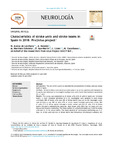Mostrar o rexistro simple do ítem
Characteristics of stroke units and stroke teams in Spain in 2018: Pre2Ictus project
| dc.contributor.author | Alonso de Ceciñana, María | |
| dc.contributor.author | Morales, Ana | |
| dc.contributor.author | Martínez-Zabaleta, Maite | |
| dc.contributor.author | Ayo-Martín, Óscar | |
| dc.contributor.author | Lizán, Luis | |
| dc.contributor.author | Castellanos, María del Mar | |
| dc.date.accessioned | 2024-06-21T08:04:22Z | |
| dc.date.available | 2024-06-21T08:04:22Z | |
| dc.date.issued | 2022-06-30 | |
| dc.identifier.citation | Alonso de Leciñana M, Morales A, Martínez-Zabaleta M, Ayo-Martín Ó, Lizán L, Castellanos M; en representación de los investigadores del Proyecto Ictus, GEECV-SEN. Characteristics of stroke units and stroke teams in Spain in 2018: Pre2Ictus project. Neurologia (Engl Ed). 2023 Apr;38(3):173-180. English, Spanish. | es_ES |
| dc.identifier.issn | 2173-5808 | |
| dc.identifier.uri | http://hdl.handle.net/2183/37253 | |
| dc.description.abstract | [Abstract] Introduction: The aim of this work is to describe the characteristics of stroke units and stroke teams in Spain. Method: We performed a cross-sectional study based on an ad hoc questionnaire designed by 5 experts and addressed to neurologists leading stroke units/teams that had been operational for ≥ 1 year. Results: The survey was completed by 43 stroke units (61% of units in Spain) and 14 stroke teams. The mean (SD) number of neurologists assigned to each unit/team is 4±3. 98% of stroke units (and 38% of stroke teams) have a neurologist on-call available 24hours, 365 days. 98% of stroke units (79% of stroke teams) have specialised nurse, 95% of units (71% of stroke teams) auxiliary personnel, 86% of units (71% of stroke teams) social worker, 81% of stroke units (71% of stroke teams) have a rehabilitation physician and 81% of stroke units (86% of stroke teams) a physiotherapist. Most stroke units (80%) have 4-6 beds with continuous non-invasive monitoring. The mean number of unmonitored beds is 14 (8) for stroke units and 12 (7) for stroke teams. The mean duration of non-invasive monitoring is 3 (1) days. All stroke units and 86% of stroke teams have intravenous thrombolysis available, and 81% of stroke units and 21% of stroke teams are able to perform mechanical thrombectomy, whereas the remaining centres have referral pathways in place. Telestroke systems are available at 44% of stroke units, providing support to a mean of 4 (3) centres. Activity is recorded in clinical registries by 77% of stroke units and 50% of stroke teams, but less than 75% of data is completed in 25% of cases. Conclusions: Most stroke units/teams comply with the current recommendations. The systematic use of clinical registries should be improved to further improve patient care. | es_ES |
| dc.description.abstract | [Resumen] Introducción. El objetivo del trabajo es describir las características de las unidades (UI) y equipos (EI) de ictus en España. Método. Estudio transversal basado en un cuestionario ad-hoc, diseñado por 5 expertos y dirigido a los neurólogos responsables de las UI/EI con al menos un año de funcionamiento. Resultados. Participaron 43 UI (61% del total) y 14 EI. La media (±DE) de neurólogos adscritos a las UI/EI es de 4 ± 3. 98% de las UI frente a 38% de EI cuentan con neurólogo de guardia 24 h/7d. Disponen de enfermería especializada 98% de las UI frente a 79% de los EI, de médico rehabilitador 81% frente a 71% y de trabajador social 86% frente a 71%. La mayoría de UI (80%) tienen 4-6 camas con monitorización continua no invasiva. El número medio de camas no monitorizadas de las UI es de 14 ± 8 y de 12 ± 7 en los EI. La estancia media de los pacientes en las camas monitorizadas de las UI es de 3 ± 1 días. Todas las UI y el 86% de EI pueden realizar trombólisis intravenosa; el 81% de UI y 21% de EI trombectomía mecánica; el resto de los centros tiene posibilidad de derivación. El 44% de UI dispone del sistema teleictus, dando soporte a 4 ± 3 centros. La actividad se recoge sistemáticamente en el 77% de UI y 50% de EI, pero su cumplimentación es < 75% en un 25% de los casos. Conclusiones. La mayoría de las UI y de los EI cumple las recomendaciones actuales. Para seguir mejorando la atención del paciente, resulta necesario optimizar el registro sistemático de su actividad. | es_ES |
| dc.language.iso | eng | es_ES |
| dc.publisher | Elsevier | es_ES |
| dc.relation.uri | https://doi.org/10.1016/j.nrl.2020.06.012 | es_ES |
| dc.rights | Creative Commons Attribution-NonCommercial-NoDerivs 4.0 International License (CC-BY-NC-ND 4.0) | es_ES |
| dc.rights.uri | http://creativecommons.org/licenses/by-nc-nd/3.0/es/ | * |
| dc.subject | Stroke | es_ES |
| dc.subject | Service organization | es_ES |
| dc.subject | Equipment | es_ES |
| dc.subject | Resources | es_ES |
| dc.subject | Care quality | es_ES |
| dc.subject | Telemedicine | es_ES |
| dc.subject | Ictus | es_ES |
| dc.subject | Organización | es_ES |
| dc.subject | Dotación | es_ES |
| dc.subject | Recursos | es_ES |
| dc.subject | Calidad asistencial | es_ES |
| dc.subject | Telemedicina | es_ES |
| dc.title | Characteristics of stroke units and stroke teams in Spain in 2018: Pre2Ictus project | es_ES |
| dc.title.alternative | Características de las unidades de ictus y equipos de ictus en España en el año 2018: Proyecto Pre2Ictus | es_ES |
| dc.type | info:eu-repo/semantics/article | es_ES |
| dc.rights.access | info:eu-repo/semantics/openAccess | es_ES |
| UDC.journalTitle | Neurología (English Edition) | es_ES |
| UDC.volume | 38 | es_ES |
| UDC.issue | 3 | es_ES |
| UDC.startPage | 173 | es_ES |
| UDC.endPage | 180 | es_ES |
| dc.identifier.doi | 10.1016/j.nrl.2020.06.012 |
Ficheiros no ítem
Este ítem aparece na(s) seguinte(s) colección(s)
-
INIBIC-EC-Artigos [25]






